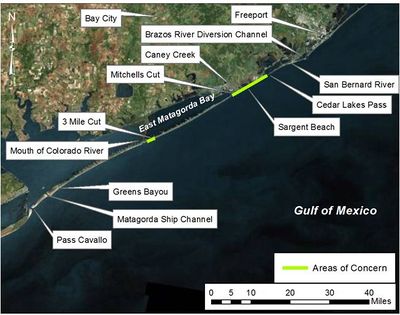Sargent Beach Lessons Learned
Introduction and Study Overview
The Port of Bay City, Texas, asked the U.S. Army Corps of Engineers to develop potential structural solutions to reduce erosion of critical beach baitat and to increase protection from tropical storms in Matagorda County. The two primary areas of concern are Sargent Beach and a 2-3 mile stretch of beach on Matagorda Peninsula located about a mile east of the Mouth of the Colorado River (MCR). This two-part study investigated the coastal processes of the region and introducted several structural alternatives to reduce erosion. Phase 1 of the study investigated the coastal processes and determined which structural solutions would be evaluated further in Phase 2. Figure 1 shows a map of the project area and region.
This study was presented in a series of technical reports. Phase 1 was published in 2012 while the Phase 2 report is available as a draft. Since this was a very in-depth study and included analysis with several models, the details of the study will not be presented here. Instead, basic details of the GenCade analysis will be shown. In addition, this study allowed the GenCade team learn several lessons related to the model and improve GenCade for future studies. These lessons are presented here to provide additional information for GenCade users.
Matagorda Peninsula
The orginal objectives at Matagorda Peninsula were to reduce erosion and increase beach width over a defined target area. Following a presentation of the Phase 1 results to the sponsor, the final project goals were refined as listed below.
- Establish a groin field to stabilize the beach from the north access road to 3 Mile Cut.
- Increase the dry beach width by 200 ft over this area.
- Ensure no impact to shoreline change at 3 Mile Cut.
- Exclude bypassing plants at MCR. Natural bypassing and dredging at MCR and placement near the west beach migth occur (various levels of federal funded bypassing are considered in the shoreline modeling, although no additional non-federal bypassing was recommended or tested.)
Several alternatives were modeled in addition to the existing condition. Many of the initial groin configurations resulted in accretion near 3 Mile Cut, which was undesirable because it could change the way the ephemeral inlet has functioned. Therefore, each of the alternatives was rerun with the groin field shifted 1,640 ft to the southwest. The best performing alternative was Alternative 5-Shifted. The alternatives considered are shown below.
- Alternative 0 - No action, no groins constructed
- Alternative 1 - Seven groins, 400 ft long, 800 ft apart (last three groins shorter and closer together); first groin approximately 2,500 ft southwest of 3 Mile Cut
- Alternative 1 - Shifted - Same as Alternative 1, groins shifted 1,640 ft to southwest
- Alternative 2 - Five groins, 400 ft long, 1,200 ft apart (last two shorter and closer together); first groin 2,500 ft southwest of 3 Mile Cut
- Alternative 2 - Shifted - Same as Alternative 2, groins shifted 1,640 ft to southwest
- Alternative 3 - Five groins, 600 ft long, 1,200 ft apart (last two are shorter and closer together); first groin 2,500 ft southwest of 3 Mile Cut
- Alternative 3 - Shifted - Same as Alternative 3, groins shifted 1,640 ft to southwest
- Alternative 4 - Five groins, 600 ft long, 1,800 ft apart (last two shorter and closer together); first groin 2,500 ft southwest of 3 Mile Cut
- Alternative 4 - Shifted - Same as Alternative 4, groins shifted 1,640 ft to southwest
- Alternative 5 - Three groins, 800 ft long, 1,600 ft apart
- Alternative 5 - Shifted - Same as Alternative 5, groins shifted 1,640 ft to southwest
To find out more about the alternatives that were not selected, please refer to the Phase 2 report. Only Alternative 5 - Shifted and non-structural solutions will be discussed here.
The model domain was 28 miles long, extending about 3.3 miles southwest of Mitchell's Cut to about 8.7 miles southwest of MCR (Figure 2). The model was run for 5 and 16 years.
The baseline is to take no action. There are also three variations without structures that were simulated. The four cases are no action (no beach fill, no mechanical bypassing), a 200-ft wide beach fill without mechanical bypassing, 200,000 cu yd/yr of mechanical bypassing without a beach fill, and a 200-ft wide beach fill with 200,000 cu yd/yr of mechancial bypassing. Figure 3 compares the four variations of non-structural alternatives after 5 years while Figure 4 shows the variations after 16 years.
The same variations of beach fills and mechanical bypassing were included in the Alternative 5 - Shifted setup. The results of those four variations of Alterantive 5 - Shifted are compared with the no action baseline case after 5 and 16 years (Figures 5 and 6). Regardless of the amount of bypasing and the construction of a beach fill, the shoreline will advance updrift and erode downdrift of the groin field. None of the alternatives resulted in the suggested 200 ft of shoreline advance across the range of the project, even when a beach fill was added. Of all of the modeled alternatives, Alternative 5 - Shifted provided shoreline advance most similar to the recommended project requirements. The wide range of results between the bypassing and no bypassing variations illustrates the need for monitoring at MCR.
